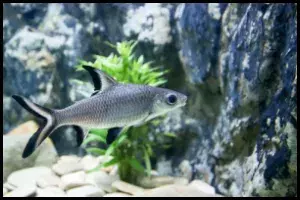
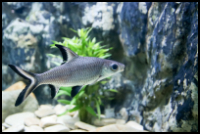
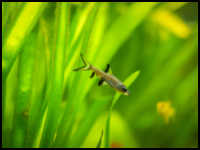
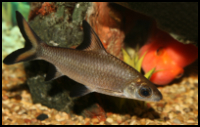
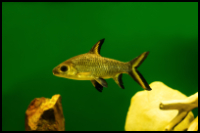
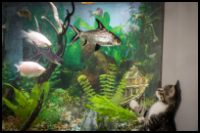
Quick Care Details (Table)
| Livestock Characteristics | Value |
|---|---|
| Care Level | Moderate |
| Temperament | Semi-Aggressive |
| Diet | Omnivore |
| Maximum Size | 1ft 2 Inches |
| Minimum Tank Size | 125 Gallons |
| Plant Safe | Yes |
| Temperature Range | 72-80F |
| PH Range | 6.5-7.5 |
| KH Range | 10-15 |
Species Specific Categories
Helpful Video
Care Details
Aquascape: Imagine creating an aquatic paradise. Bala Sharks prefer a spacious tank with open swimming areas. Rocks, driftwood, and some hearty, fast-growing plants are great additions to mimic their natural habitat.
Substrate: They aren't too picky about substrate, but a fine gravel or sand bottom works well. Think of it like choosing the right flooring for your home – comfort and aesthetics matter.
Disease Prevention: Just like we take steps to stay healthy, maintaining good water quality, a balanced diet, and regular tank maintenance helps prevent diseases in your Bala Sharks.
Filtration: Quality filtration is like the lungs of their world. They need a robust filter to keep the water clean and well-oxygenated.
Lighting: Bala Sharks prefer subdued lighting to replicate their native rivers. It's akin to choosing soft, ambient lighting in your living space for a cozy atmosphere.
Water Flow: They enjoy a gentle water flow. It's like having a refreshing breeze in your home, making it pleasant and comfortable.
Hardiness: Bala Sharks are fairly hardy but can be sensitive during acclimation. It's similar to how we might feel after a long flight – a bit jet-lagged initially.
Acclimation: When introducing them to a new tank, a gradual acclimation process helps them adapt comfortably, like settling into a new neighborhood.
Expected Lifespan: With proper care, they can live for over a decade, almost like having a long-term companion in your home.
Special Requirements: They don't have many special needs, but offering them a spacious planted and well-maintained home with suitable tank mates is key. Think of it as creating a welcoming environment for your unique, aquatic roommates.
Temperament and Behavior
Behavior: Bala Sharks are like the social butterflies of the fish tank. They're active and love to swim around, often exploring different areas. They're not shy and can be quite entertaining to watch.
Breeding: Breeding Bala Sharks in spacious home aquariums is quite challenging due to their specific breeding requirements. It's a bit like trying to create the perfect environment for a rare orchid to bloom.
Aggression: In general, Bala Sharks are peaceful and get along well with other non-aggressive fish. However, they can sometimes get a bit competitive during feeding time, like siblings vying for the last piece of pizza.
Tankmates Compatibility: These sharks are friendly and can coexist with a variety of community fish. It's similar to having a harmonious neighborhood where different families live together peacefully.
Activity Level: Bala Sharks are like fitness enthusiasts, constantly on the move. They need a spacious tank to accommodate their active lifestyle, akin to us needing a spacious gym to exercise.
Schooling Behavior: Bala Sharks exhibit strong schooling behavior. They're like friends who stick together, creating a tight-knit group, and they feel more secure and relaxed when surrounded by their school.
Plant Compatibility: They might nibble on plants occasionally, so it's essential to have hardy, fast-growing plants in your home aquarium. It's similar to having indoor plants that can withstand a bit of pruning and still thrive.
Diet and Nutrition
Dry Foods: Bala Sharks are quite the enthusiasts when it comes to dry foods. They'll happily chomp down on high-quality flake foods and pellets, much like us enjoying our favorite snacks, be it potato chips or popcorn.
Frozen Foods: For a special treat, indulge your Bala Sharks with frozen foods like bloodworms and brine shrimp. Think of it as treating them to a fancy dinner, like going out for pizza or sushi.
Live Foods: Bala Sharks really get their appetites going with live foods such as daphnia or mosquito larvae. It's like going to a seafood restaurant and savoring fresh catch from the ocean.
Vegetables: Occasionally, you can offer them some blanched vegetables like zucchini or spinach as a side dish. It's like adding a healthy salad to their main course, keeping their diet diverse.
Algae: Although they may graze on some algae naturally, it's not their main course. Think of it as a light snack, like enjoying some kale chips or a green smoothie to stay healthy.
Feeding Schedule: They should be fed 2-3 times a day, ensuring they don't overindulge. Just like us with breakfast, lunch, and dinner, but with smaller portions to keep them in shape.
Supplemental Foods: Occasionally, you can treat them with live or frozen foods, adding excitement to their diet. It's like giving them dessert or a special treat to brighten their day.
Tank Parameters
0
History, Popularity, History and Species Variety Details
The History, Popularity and Natural Habitat
History: The Bala Shark, scientifically known as Balantiocheilus melanopterus, hails from the rivers of Southeast Asia, predominantly found in countries like Thailand and Malaysia. Initially discovered in the early 19th century, these fish quickly became popular in the aquarist community due to their striking appearance and active nature. Their streamlined body and silvery sheen make them reminiscent of actual sharks, hence the name.
Popularity: Bala Sharks have earned their place in the hearts of aquarists around the world. Their peaceful temperament and schooling behavior, much like their distant shark cousins, make them a sought-after addition to community tanks. They bring a sense of activity and vibrancy to the underwater world, a trait that endears them to both beginners and experienced fish enthusiasts.
Natural Habitat: In their native habitat, Bala Sharks inhabit clear, fast-flowing rivers and streams with plenty of vegetation. These water bodies are characterized by warm, tropical climates, which the fish have adapted to over centuries. Their natural surroundings often feature submerged logs and rocky formations, elements you can consider when creating their ideal tank environment.
Understanding the historical roots, the widespread popularity, and the natural habitat of Bala Sharks provides a deeper connection to these captivating fish as you care for them in your own aquatic haven. It's like bringing a piece of Southeast Asia's rivers right into your living space.
Back to topFish that are similar to the Bala Shark
- Redtail Shark (Epalzeorhynchos bicolor): The Redtail Shark is another popular aquarium fish with a dark body and striking red tail fin. They are known for their territorial behavior.
- Rainbow Shark (Epalzeorhynchos frenatum): The Rainbow Shark is closely related to the Redtail Shark, featuring a black body with vibrant red or orange fins. They are also territorial and can be a bit aggressive.
- Denison Barb (Sahyadria denisonii): Sometimes called the "Red-line Torpedo Barb," these fish have a torpedo-like shape and feature red lines along their body. They are more peaceful than the Redtail and Rainbow Sharks.
- Columbian Shark (Arius jordani): The Columbian Shark, also known as the Jordan's Catfish, has a sleek appearance and is silver-gray in color. They are more elongated compared to the other "sharks."
Back to top
Frequently Asked Questions
Do they have any special lighting needs?
They prefer subdued lighting, mimicking their natural habitat in Southeast Asia.
How can I tell males from females?
Distinguishing between sexes can be challenging. Males may be slightly smaller and more slender, while females might appear plumper when carrying eggs.
What water conditions do they prefer?
Bala Sharks prefer slightly acidic to neutral water with a pH of 6.5-7.5 and relatively soft to moderately hard water. Monitoring water quality is essential.
Can I keep a single Bala Shark?
They are social creatures and do best in groups of three or more. Think of it as providing them a little fishy community to interact with.
How long do they live?
With proper care, Bala Sharks can live up to 10-15 years. That's like having a long-term companion in your aquatic world.
Are they jumpers?
Yes, Bala Sharks can be prone to jumping, so ensure your tank has a secure lid to prevent any escapes.
How do I acclimate them to my tank?
Slowly introduce them to your tank water by floating the bag in the tank for about 15-20 minutes, and then release them. It's like a warm welcome to your new home.
Do they need a heater?
Yes, they prefer water between 72-82°F (22-28°C). A heater keeps their environment cozy.
How big should their tank be?
Plan on a spacious tank, at least 75 gallons for a group. It's like ensuring your roommates have enough space to move around comfortably.
Can they live with other fish?
They're generally peaceful, but they thrive with fish of similar size and temperament. Avoid housing them with nippy or aggressive species.
What should I feed them?
They enjoy a varied diet, including high-quality flakes, pellets, and occasional live or frozen foods like brine shrimp. Think of it like offering them a diverse menu.
Are they actual sharks?
No, they're not real sharks. They're freshwater fish with a streamlined shape resembling a shark.
How big do Bala Sharks get?
Bala Sharks can reach up to 14 inches (35 cm) in length, so be prepared for some growth.

